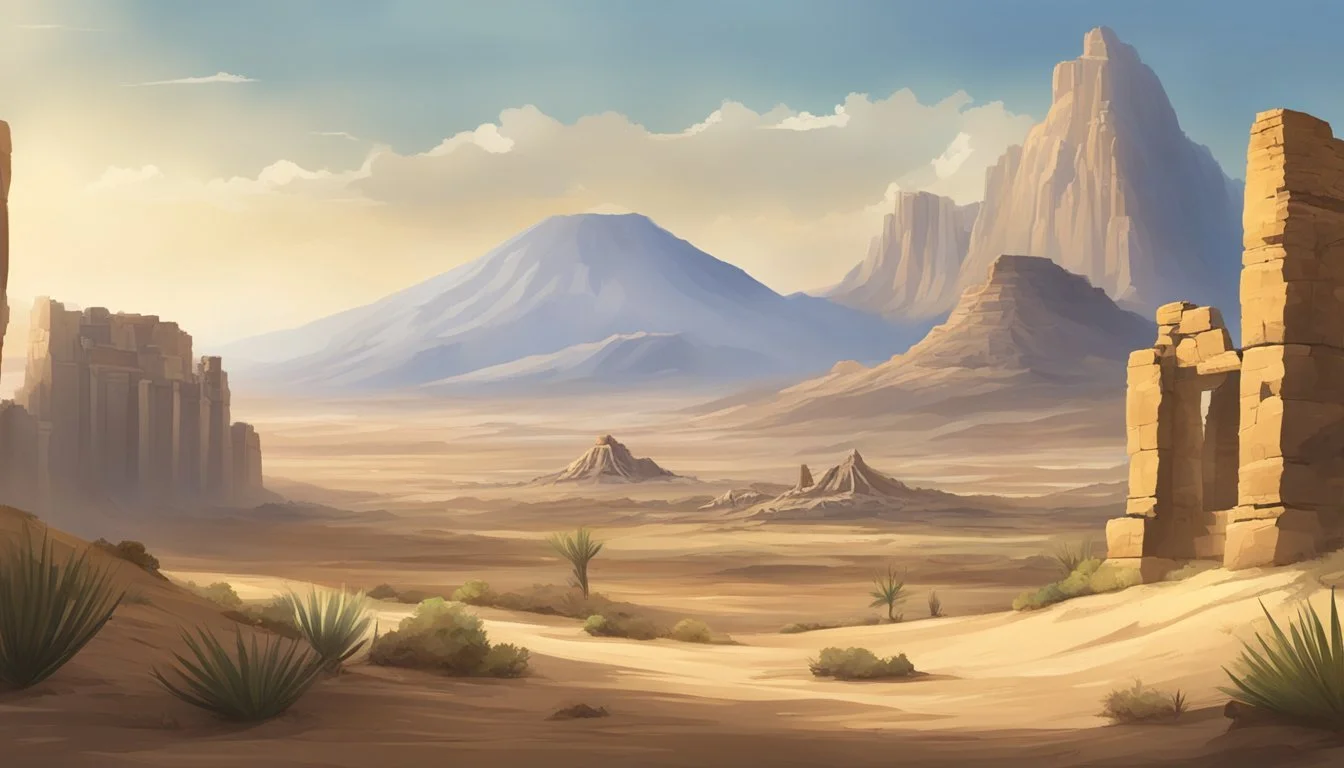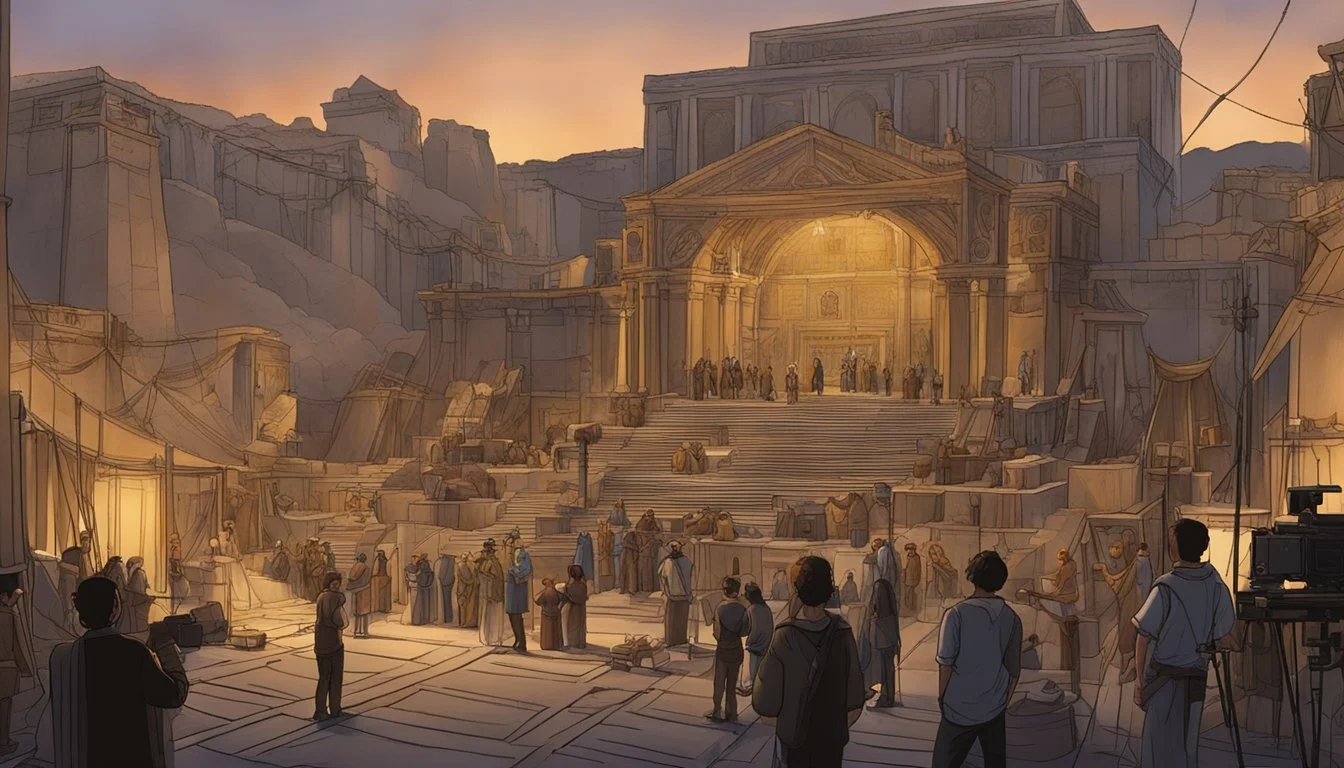Behind the Scenes: The Making of 'Testament: The Story of Moses
Crafting Biblical Epic for the Screen
Netflix's "Testament: The Story of Moses" offers viewers a fresh perspective on the iconic biblical figure. This three-part docudrama series blends dramatic reenactments with expert commentary to explore Moses' journey from exile to liberator. The show aims to humanize Moses, shedding light on his personal struggles and inner life often overlooked in traditional retellings.
The production team, led by Emre Sahin and Kelly McPherson, crafted a visually stunning portrayal of ancient Egypt and the Exodus. Istanbul-based Mojo FX provided impressive visual effects, enhancing the series' epic scale. Charles Dance's narration guides viewers through the story, while Clarke Peters lends his voice to the role of God.
"Testament: The Story of Moses" combines historical accuracy with compelling storytelling. The series features insights from theologians and historians, offering a nuanced exploration of one of history's most enduring narratives. By focusing on Moses' humanity, the show creates a relatable and thought-provoking experience for both newcomers and those familiar with the biblical account.
Contextualizing 'Testament'
'Testament: The Story of Moses' taps into a narrative deeply embedded in religious and cultural history. The series explores themes of identity, leadership, and social justice through the lens of this pivotal biblical figure.
Cultural and Historical Significance
Moses stands as a central figure in Jewish, Christian, and Islamic traditions. His story, chronicled in the Old Testament, has shaped laws, ethics, and social structures across millennia. 'Testament' delves into the historical context of ancient Egypt and the Israelites' exodus.
The series examines archaeological evidence and historical records to provide a nuanced portrayal of the era. It highlights the political and social dynamics of the time, offering viewers insight into the world Moses inhabited.
By exploring Moses' journey from prince to prophet, 'Testament' illuminates themes of identity and purpose that resonate across cultures. The show's depiction of the Ten Commandments underscores their enduring impact on legal and moral frameworks worldwide.
Religious Impact and Perspectives
'Testament' navigates the delicate balance between faith and historical interpretation. The series presents diverse religious perspectives on Moses' life and legacy, acknowledging his significance across Abrahamic religions.
It explores how different faith traditions view key events like the burning bush and the parting of the Red Sea. The show considers both literal and symbolic interpretations of these moments, fostering dialogue about their meaning.
'Testament' also addresses Moses' role as a liberator and lawgiver, examining how his actions have inspired social justice movements throughout history. The series invites viewers to reflect on the relevance of Moses' teachings in contemporary society.
Creative Vision Behind the Series
"Testament: The Story of Moses" blends historical research, dramatic reenactments, and expert commentary to offer a fresh perspective on the biblical legend. The series aims to humanize Moses while maintaining the epic scale of his journey.
Director's Inspiration
Emre Sahin, co-producer of the series, drew inspiration from the rich tapestry of Moses' life. He sought to portray Moses as a relatable figure, balancing his humanity with his divine calling. Sahin incorporated lesser-known Jewish texts, such as midrash, to add depth to the narrative.
The creative team aimed to make the story accessible to both newcomers and those familiar with the biblical account. They focused on Moses' personal struggles and growth, from his time as an Egyptian prince to his role as a prophet and liberator.
Writing and Storytelling
Kelly McPherson, alongside the writing team, crafted a narrative that combines historical accuracy with compelling storytelling. They carefully wove together elements from various sources, including the Torah and extra-biblical texts.
The writers paid special attention to character development, particularly for minor figures like Serach bat Asher. This approach added layers to the story and provided fresh insights for viewers with prior knowledge of Moses' tale.
The team structured the series in three parts, allowing for a comprehensive exploration of Moses' journey. They balanced dramatic reenactments with expert commentary to provide context and depth to the narrative.
Production Insights
"Testament: The Story of Moses" blends documentary elements with dramatic reenactments to bring the biblical narrative to life. The production team employed innovative techniques to create an immersive viewing experience.
Filming and Locations
The series utilized diverse locations to recreate ancient Egypt and the Sinai desert. Filming took place in Morocco, where expansive landscapes provided an authentic backdrop for Moses' journey. The production design team meticulously crafted sets to depict Egyptian cities and Hebrew settlements.
Specialized camera techniques captured the grandeur of key scenes. Drone footage showcased the vast desert expanses, while handheld cameras added intimacy to character interactions. The visual effects team enhanced certain shots to portray biblical miracles realistically.
Dramatic Reenactments
Actors were carefully selected to portray key figures in Moses' story. The casting process focused on finding performers who could convey the emotional depth of their characters. Costume designers created historically accurate attire, blending research with artistic interpretation.
The series employed a hybrid approach, interweaving reenactments with expert commentary. This technique allowed for a balance between narrative storytelling and historical context. Directors worked closely with religious scholars to ensure respectful and accurate portrayals of sacred events.
Choreographers staged large-scale scenes, such as the Exodus, to create visually striking moments. The production team used a combination of practical effects and CGI to bring pivotal moments like the parting of the Red Sea to life on screen.
Casting and Characters
The casting choices for "Testament: The Story of Moses" brought biblical figures to life through talented actors. Key roles were filled by experienced performers, while supporting characters added depth to the narrative.
Main Cast Profiles
Charles Dance lends his voice as the narrator, guiding viewers through Moses' journey. Clarke Peters portrays an older Moses, bringing gravitas to the prophet's later years.
Avi Azulay takes on the challenging role of young Moses, depicting his transformation from prince to outcast. Dominique Tipper plays Zipporah, Moses' wife and a source of strength throughout his trials.
Ishai Golan embodies Aaron, Moses' brother and spokesperson. The actor captures Aaron's loyalty and occasional doubts as he supports Moses' mission.
Supporting Roles Significance
The Pharaoh, as Moses' primary antagonist, is a crucial character. The actor in this role conveys both the ruler's stubbornness and vulnerability as plagues strike Egypt.
Hebrew midwives play a small but vital part in the story. These brave women defy Pharaoh's orders, setting the stage for Moses' survival as an infant.
Serach Bat Asher, though not widely known, is portrayed as a wise woman who helps preserve Hebrew traditions during captivity. This character adds depth to the depiction of Israelite culture.
Theological and Academic Perspectives
"Testament: The Story of Moses" incorporates diverse scholarly viewpoints to provide depth and nuance to its portrayal of the biblical prophet. Theologians, historians, and religious studies experts offer insights that both support and challenge traditional interpretations of Moses' life and legacy.
Expert Commentary
The series features commentary from religious leaders and scholars who provide context for the dramatized scenes. Rabbi Maurice Harris offers perspectives on Midrashic interpretations of Moses' early life in Egypt. Biblical historians discuss archaeological evidence related to the Exodus narrative, highlighting areas of debate within academic circles.
Religious studies professors analyze the cultural impact of Moses as a prophetic figure across different faith traditions. Their insights shed light on how various communities have understood and reinterpreted Moses' story over time.
Scholarly Analysis
Academics in the series examine potential historical inaccuracies in the biblical account, discussing how these impact modern understandings of Moses. They explore theories about the development of monotheism and the formation of ancient Israelite identity.
Experts debate the historicity of specific events like the plagues and the parting of the Red Sea. Some scholars present naturalistic explanations for these phenomena, while others argue for their symbolic or mythological significance.
The show also addresses how modern archaeological findings have influenced academic perspectives on the Exodus narrative. This balanced approach allows viewers to consider multiple interpretations of the Moses story.
Cultural Resonance and Current Relevance
The story of Moses continues to resonate across cultures and religions, influencing modern interpretations and media representations. Its themes of liberation, leadership, and faith remain relevant to contemporary audiences.
Modern Interpretations
The Moses narrative holds significance for diverse groups today. Muslims revere Moses as an important prophet in Islam. Many women find inspiration in the courage of Miriam and other female figures. Social justice movements draw parallels to the Israelites' struggle for freedom.
The Emancipation Proclamation and civil rights era saw frequent allusions to Moses leading his people to freedom. Today, refugees and marginalized communities often identify with the Exodus story.
Religious leaders and scholars continue to find new meanings in the text, applying its lessons to current ethical and social issues.
Media and Representation
Popular culture frequently references and reimagines the Moses story. The 1998 animated film "The Prince of Egypt" brought the tale to new generations. Recent adaptations aim for historical accuracy and cultural authenticity.
"Testament: The Story of Moses" takes a fresh approach by exploring Moses' humanity and inner struggles. This portrayal resonates with viewers seeking relatable characters.
Television series, novels, and stage productions continue to reinterpret the narrative for modern audiences. These adaptations often reflect contemporary values and concerns, making the ancient story feel relevant and accessible.
Reception and Impact
"Testament: The Story of Moses" garnered significant attention as a faith-based series, attracting viewers and critics alike. The show's portrayal of Moses and its approach to biblical storytelling sparked discussions across various audiences.
Viewer Reception
"Testament" quickly became one of Netflix's top shows, with 13.5 million streams in its first five days. This viewership nearly matched the global Jewish population, indicating broad appeal beyond religious demographics. The series resonated with audiences seeking a fresh perspective on the familiar biblical narrative. Many viewers appreciated the humanization of Moses, finding his personal struggles relatable. The show's blend of drama and historical context appealed to those interested in both faith and history.
Critical Reviews and Ratings
Critics praised "Testament" for its nuanced portrayal of Moses, lifting the superhuman stigma often associated with biblical figures. The series was commended for its historical accuracy and production values. Some reviewers drew comparisons to other successful faith-based productions like "The Chosen." Critics noted the show's ability to spark meaningful conversations about faith and spirituality. While generally positive, some reviews questioned certain creative liberties taken with the biblical text. Overall, "Testament" was recognized for its fresh approach to biblical storytelling in the streaming era.
Supplementary Material and Further Learning
"Testament: The Story of Moses" offers a starting point for deeper exploration of this biblical figure. Various educational resources and related films provide additional perspectives on Moses and the Exodus narrative.
Educational Resources
Several books offer in-depth analysis of Moses and the Ten Commandments. "Moses: A Life" by Jonathan Kirsch examines the historical and cultural context of the Exodus story. For a scholarly approach, "The Exodus" by Richard Elliott Friedman explores archaeological evidence related to the biblical account.
Online courses from universities and religious institutions delve into Moses' life and leadership. Coursera offers "The Bible's Prehistory, Purpose, and Political Future," which includes modules on Exodus. Yale University provides free video lectures on Old Testament studies through Open Yale Courses.
Biblical archaeology magazines and websites feature articles on recent discoveries related to the Exodus period. The Biblical Archaeology Society offers webinars and digital archives exploring historical evidence for Bible stories.
Related Documentaries and Films
Cecil B. DeMille's 1956 epic "The Ten Commandments" remains a classic portrayal of Moses' life, often broadcast during Passover and Easter. The 1998 animated film "The Prince of Egypt" presents a family-friendly version of the Exodus story with award-winning music.
For a documentary approach, "Patterns of Evidence: Exodus" (2014) examines archaeological findings related to the biblical narrative. The History Channel's "The Bible" miniseries includes episodes devoted to Moses and the Exodus.
BBC's "The Bible's Buried Secrets" offers a more critical examination of biblical stories, including segments on Moses and the Ten Commandments. National Geographic's "The Story of God with Morgan Freeman" features an episode exploring the concept of exodus across different faiths.



